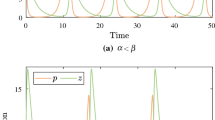Abstract
We propose a lattice Monte Carlo model of two populations, predators and prey. We divide predators into cooperative predators and defective predators. Cooperative predators participate in hunting. On the other hand, defective predators only participate to dominate, i.e. take possession of, the food when a kill has already been made by a cooperative predator. Numerous factors have been taken into account in our research, such as individual mobility, predation and hunger time. The model we have constructed displays the features of the population that evolve through time and the spatial distribution of the population. We focus on the emergence of defective predators and how the parameters affect the system. The results indicate that prey can profit from the appearance of these defective predators in some specific situations. It has even been shown that the emergence of defective predators can sometimes save endangered systems.
Similar content being viewed by others
References
M. Droz, A. Pekalski, Eur. Phys. J. B 77, 581 (2010)
M. Droz, A. Pekalski, Phys. Rev. E 63, 1909 (2001)
M. Droz, A. Pekalski, Physica A 391, 1243 (2012)
J. Szwabiski, A. Pekalski, I. Bena, M. Droz, Physica A 389, 2545 (2010)
A. Pekalski, J. Szwabiski, Physica A 392, 710 (2013)
X. Wang, M. He, Y. Kang, Physica A 391, 664 (2012)
F.M. Hilker, M.A. Lewis, Theor. Ecol. 3, 175 (2010)
M. Banerjee, S. Petrovskii, Theor. Ecol. 4, 37 (2010)
A. Yokoyama, Y. Noguchi, S. Nagano, J. Biol. Phys. 34, 121 (2008)
M. Carneiro, I. Charret, Phys. Rev. E 76, 061902 (2007)
D. Maionchi, S. Dosreis, M. Deaguiar, Ecol. Model. 191, 291 (2006)
M. Sieber, H. Malchow, S.V. Petrovskii, Proc. R. Soc. Math. Phys. Eng. Sci. 466, 1903 (2010)
X. Ni, W.-X. Wang, Y.-C. Lai, C. Grebogi, Phys. Rev. E 82, 016210 (2010)
J.A. Sherratt, M.J. Smith, J.D.M. Rademacher, Proc. Natl. Acad. Sci. USA 106, 10890 (2009)
M.J. Smith, J.A. Sherratt, X. Lambin, J. Theor. Biol. 254, 264 (2008)
M.J. Smith, J.A. Sherratt, N.J. Armstrong, Proc. R. Soc. Math. Phys. Eng. Sci. 464, 365 (2008)
J.A. Sherratt, M.J. Smith, J. R. Soc. Interface 5, 483 (2008)
J.A. Sherratt, J. Appl. Math. 73, 759 (2008)
M.J. Smith, J.A. Sherratt, Physica D 236, 90 (2007)
J.A. Sherratt, SIAM J. Appl. Math. 63, 1520 (2003)
C. Durney, S. Case, M. Pleimling, R. Zia, Phys. Rev. E 83, 051108 (2011)
D.R. MacNulty, D.W. Smith, L.D. Mech, L.E. Eberly, J. Anim. Ecol. 78, 532 (2009)
D.R. MacNulty, D.W. Smith, L.D. Mech, J.A. Vucetich, C. Packer, Behavioral Ecology 23, 75 (2012)
D.R. MacNulty, D.W. Smith, J.A. Vucetich, L.D. Mech, D.R. Stahler, C. Packer, Ecology Lett. 12, 1347 (2009)
C.E. Tarnita, N. Wage, M.A. Nowak, Proc. Natl. Acad. Sci. USA 108, 2334 (2011)
M. Perc, A. Szolnoki, Biosystems 99, 109 (2010)
A. Szolnoki, M. Perc, Europhys. Lett. 92, 38003 (2010)
M.A. Nowak, C.E. Tarnita, T. Antal, Philos. Trans. R. Soc. B 365, 19 (2010)
M.A. Nowak, Science 314, 1560 (2006)
M.A. Nowak, A. Sasaki, C. Taylor, D. Fudenberg, Nature 428, 646 (2004)
R.M. Nowak, Walker’s Mammals of the World (Johns Hopkins University Press, Baltimore, 1999)
Author information
Authors and Affiliations
Corresponding author
Rights and permissions
About this article
Cite this article
Wang, X., Pan, Q., Kang, Y. et al. The emergence of defective predators who never hunt by themselves. Eur. Phys. J. B 86, 259 (2013). https://doi.org/10.1140/epjb/e2013-40210-5
Received:
Revised:
Published:
DOI: https://doi.org/10.1140/epjb/e2013-40210-5



